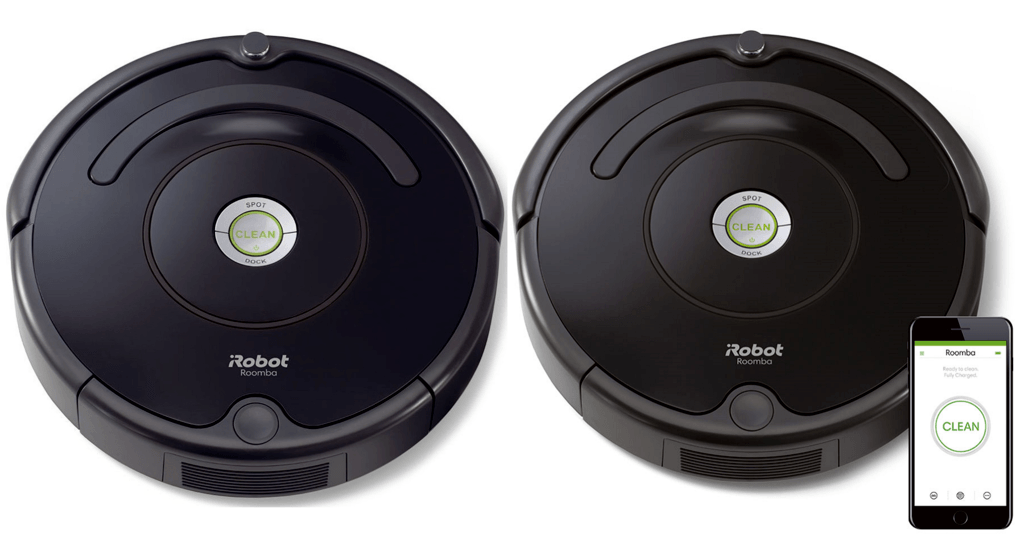Sometimes all the bells and whistles that come with robotic cleaners can be a bit too much. If you are looking to get a floor cleaning assistant and don’t want to break the bank, there is good news. The Roomba 600 series robots are still for sale and do a fantastic cleaning job.
In this article I will look at the Roomba 614, one of the most basic robots on the market. I will compare it to the slightly more expensive Roomba 675 to show you where they differ and how they clean your floors. If you are short on time, my final pick is for the Roomba 675. If you have more time, read on to find out why.
Contents
Differences between Roomba 614 and Roomba 675
To be quite honest, there is only one difference to concern yourself with. However, I will dig up as many differences for you as I can.
[easyazon_image align=”center” height=”500″ identifier=”B07DL4QY5V” locale=”US” src=”https://smartrobotichome.com/wp-content/uploads/2020/04/41nkMf9S4L.jpg” tag=”srh-easyazon-20″ width=”500″]- Wireless communications. The Roomba 675 has WiFi, the Roomba 614 does not. Without WiFi, the 614 does not use the mobile app or voice commands.
- Because of the design and lack of WiFi, there isn’t a way to schedule cleaning cycles with the 614. You can make schedules with the 675, though.
- The Roomba 614 is currently only sold (new in box) through Amazon or iRobot. The 675 is still available at most original retail stores, too, Costco, Canadian Tire, and Walmart.
- There is about a $50 difference in the price with the lower price belonging to the 614.
Similarities between Roomba 614 and Roomba 675
Aside from the four differences listed above, the rest of the features are the same. Here is a quick overview of the more important similarities.
- Automatic recharge. Both models will run for about 90 minutes before making their way back to the charging stations for a recharge.
- iAdapt navigation. The 600 series robots, including the 614 and 675, use the original sensor-based iAdapt navigation system.
- Standard AeroVac filter. You won’t get HEPA filtration with either robot, as they both use the standard AroVac filter.
- Collection bin capacity. Both robots come with a spacious 0.5L capacity collection bin.
- Extraction methods. The Roomba 614 and 675 both use the combination brush roller and rubber cleaner roller for sweeping and lifting debris.
- iRobot gives all of their robots a 1-year limited warranty, including the 614 and 675 models.
Comparison Table
Below is a side by side look at everything the two robots have to offer you (or are lacking).
| Roomba 614 | Roomba 675 | |
| Size | 13.3×13.3×3.6 inches | 13.3×13.3×3.6 inches |
| Weight | 7.8 pounds | 7.8 pounds |
| Navigation | iAdapt 1.0 | iAdapt 1.0 |
| Battery | 1800mAh Lithium-ion | 1800mAh Lithium-ion |
| Runtime | Up to 90 minutes | Up to 90 minutes |
| Charge Time | About 3 hours | About 3 hours |
| Automatic Recharge | Yes | Yes |
| Entire Level Clean | No | No |
| Filter | Standard | Standard |
| Carpet Boost | No | No |
| Drop Sensors | Yes | Yes |
| Bump Sensors | Yes | Yes |
| Dirt Detection Sensors | Yes | Yes |
| Camera Navigation | No | No |
| Wireless Communications | No | Yes |
| Mobile App | No | Yes |
| Voice Controls | No | Yes |
| Floor Types | All | All |
| Collection Bin Capacity | 0.5L | 0.5L |
| Containment | None Included | None Included |
| Warranty | 1 Year | 1 Year |
| Price | Check on Amazon | Check on Amazon |
Comparing Roomba 614 to Roomba 675 in Detail
Now it is time to find out how these robots really operate. I will dissect them according to the prominent features and tell you everything you need to know.
The Robots’ Basic Functionality
All robots start with the same basic functionality. Wheels, side brushes, filters, batteries, etc. The basic functions that make them operate. The Roomba 614 and 675 have the same basic operating parts and pieces.
The batteries, for example, are 1800mAh capacity cells, which power the robots for up to 90 minutes each. When the charge level drops to about 10 percent, the robots stop cleaning and head back to the charging docks. The Roomba 675 is a bit better at making it to the charging station, compared to the 614, so watch for that if you buy the 614 model.
Neither robot has mapmaking abilities so they cannot resume cleaning once the batteries are charged. You will need to manually restart another cleaning cycle if you plan to have them continue cleaning.
The filtration is a part of the AeroVac system that uses the standard filters. These are not HEPA filters, though, and will not collect a lot of in-home allergens. If you need your robot cleaner to help reduce allergens in your home, you will want to look at the 800 series robots, like the Roomba 890.
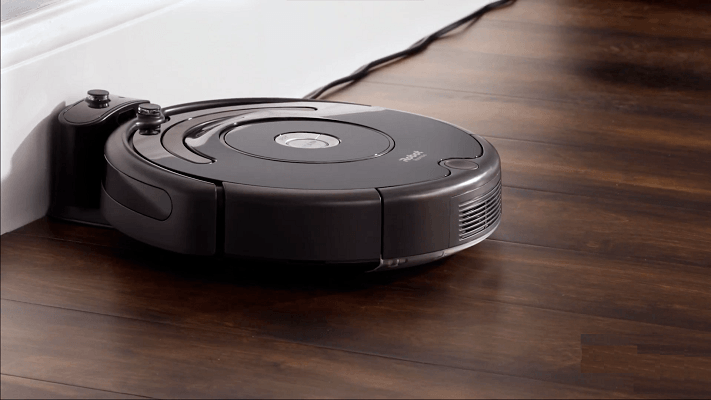
Bottom Line: When it comes to the basic functionality, the two robots are near identical. The only slight advantage goes to the 675 for being better able to return to the charging dock without dying in the middle of the floor.
Wireless Communications are the Biggest Difference
The one true difference in the Roomba 614 and 675 robots is the wireless communication abilities. The Roomba 675 has them; the 614 does not.
What does this mean for you, though? In short, the Roomba 614 only has 1 control option, the local controls on the robot itself. You can press the giant “Clean” button to send the robot off to clean the house. You also have the option of doing a spot clean or sending the robot back to the Home Base charging station.
The 675, on the other hand, has the same three local control options, with the addition of voice commands and the iRobot Home app for your mobile device.
The voice commands work with Amazon Alexa or Google Assistant and you can start, stop, pause or resume a cleaning session, send the robot home or review and create scheduled cleaning times.
With the Mobile app you can have all of those controls, as well as edit and delete schedules, get battery charge approximations, perform hardware and software updates and see valuable reports.
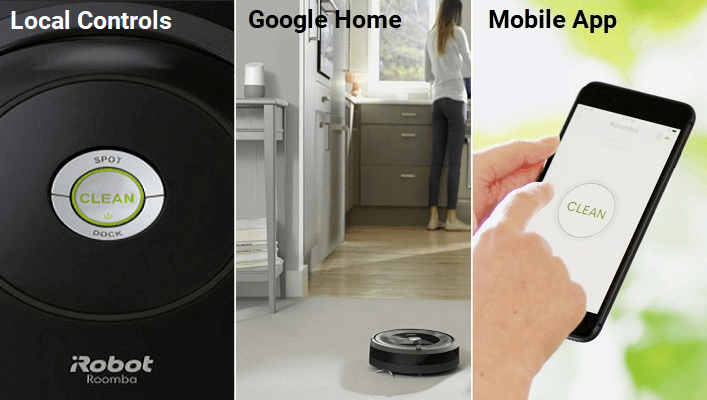
Bottom Line: This one is simple. The Roomba 675 is the better robot for the control options. The mobile app alone is worth any extra cost. Unless you really need to pinch pennies, the 675 wins overall, right here.
The Roomba 614 uses the iAdapt 1.0 sensor-based navigation system. The Roomba 675 uses this system, too. There aren’t any cameras or lasers to build or create maps. Instead, the bump-touch sensors and the drop sensors work to keep the robot on solid ground and to avoid obstacles without causing any damage.
The drop sensors detect ledges and any floor-height differences of more than about half an inch. The robot then avoids these to keep from falling down stairs or getting high-centered on ledges.
The bump sensors use infrared acoustics to detect upcoming obstacles, and the touch board on the front of the robot determines if it is a solid obstacle or a passable one. Solid obstacles cause the robot to change direction, passable objects are moved aside.
When it comes to actually cleaning the floors, the two devices use a combination set of rollers. The primary roller is a soft-bristled roller that sweeps hard flooring and lifts loosened debris from carpet fibers.
The second roller is smaller and uses rubber paddles to lightly agitate carpet and remove larger debris build-up from the main roller bristles.
The rollers will collect all types of debris, dirt, dust and even pet hair. However, with the bristles, hair, carpet fibers and string wrap around them easily. You will need to be diligent in your maintenance to keep them clean. iRobot includes a cleaning tool to help the process.
Bottom Line: No clear winner here. Both robots use the same sensors, have the same limitations and utilize the same extraction rollers.
Containment Options are Available, but not Included
The good news is that both the Roomba 675 and Roomba 614 are compatible with the dual-mode virtual wall barriers. These battery-operated towers sit on your floor and produce infrared beams to control where the robot can and cannot go.
In linear mode, the light extends straight out, up to 10 feet. This mode is useful for separating areas of larger rooms, blocking off doorways, exits, or the like. In halo mode, the light comes out as a ring, about 4-feet in diameter. Halo mode is useful for protecting Christmas trees, floor lamps and pet dishes.
The bad news is that neither the Roomba 675 or 614 come with a dual-mode virtual wall barrier. Through Amazon, though, you do have the option to include a barrier kit with your purchase. It will cost more, though, which is to be expected.
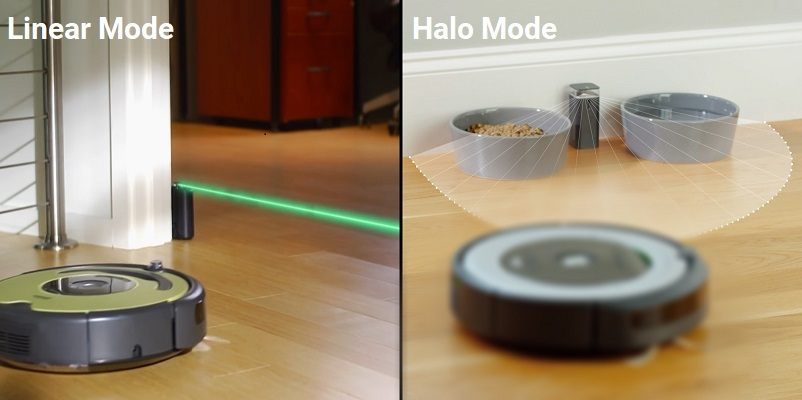
Bottom Line: Another tie, here. Both robots can use the towers, neither of them come with one by default.
Real-World Cleaning Abilities
As I am sure you are aware, the testing of these robots for their marketing, reports and evaluation numbers is done in a strictly controlled lab testing environment. As I am sure you are also aware, you do not live in a lab testing environment.
How these robots perform when the floors aren’t pre-buffed and shined and when you don’t control the exact amount of dry cereal you pour in a specific spot on the floor is what really matters. This section will let you know what you can expect in various situations in your home, when the rules aren’t so set in stone.
The Roomba 614 Vs. 675 on Carpeting
Both robots are rated to clean all carpeting, however, you will find that high-pile carpeting is not cleaned very well. Low pile and most tight-woven medium pile carpets, though, get cleaned surprisingly well.
Because of the sporadic navigation, the robots will miss some areas of your floors. However, if you run them once a day, all the areas get cleaned at least once. Some reports come in that the robots continually return to the same room or area. If you find this to be the case, you can start the robot in a different area, away from its charging station.
The side bushes don’t stop when the robot is cleaning carpet, which only works to wear them don a little faster. The biggest concern about cleaning carpet comes in the form of rugs, throws and carpeting with fringe. You will need to watch the robots for the first few cleaning cycles to make sure they can get on (or off) the rugs and that they don’t suck up the fringe and get caught. You will need to either pick up the carpeting with the fringe, or tuck the fringe underneath.
Mostly, though, you will be amazed at the amount of debris in the collection bin after just one cleaning cycle. As an investment for homes and apartments less than 1000 square feet, it is money well spent, for sure.
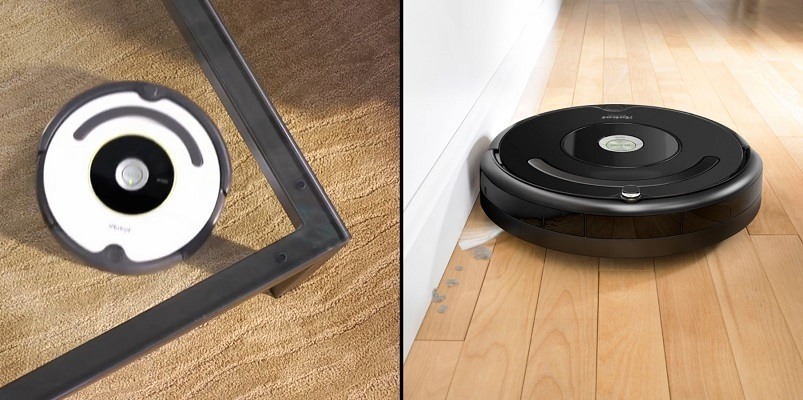
The Roomba 614 Vs. 675 on Hard Flooring
Almost every robot cleaner will excel on hard flooring. The Roomba 675 and 614 are no exception. Since there isn’t any carpeting to get in the way, the robots are free to clean the surface without having to agitate, scrub or get caught on fringe.
The side brushes here do their job and get along edges and in corners. However, prepare to be slightly disappointed in the results. The speed that the side brush rotates can cause lighter debris to fly away. It usually ends up back in the corners or along the edges. Over all, though, the robots will gather and collect about 95 to 98 percent of the debris there.
On the open floors, you won’t have any problems. Unless they run into something wet, which will cause all kinds of issues. Running the robots over your hard flooring surfaces daily will prevent you from having to sweep or getting little bits stuck to the bottom of your socks. I advise that you use the broom to brush out the corners and edges before using the Roomba’s, though.
The Roomba 614 Vs. 675 on Pet Hair
The other major area of concern is with pet hair. Roomba robots have always done an excellent job at picking up pet hair. Even in homes with multiple pets or heavy shedding breeds, the Roomba vacuums can keep up.
The main problem with the Roomba 614 and 675 models is the extraction method. The bristle brush rollers will fill with fur and hair and string at a rapid rate. For larger homes and those with a lot of pet hair to deal with, you may find yourselves stopping the cleaning cycle to perform brush cleaning maintenance on the robots.
Obviously, this isn’t a good thing, but it isn’t the end of the world, either. Unless you want to upgrade to the Roomba 960 or other models with the brushless extractors, you will need to keep up with the brush cleaning on a more regular basis.
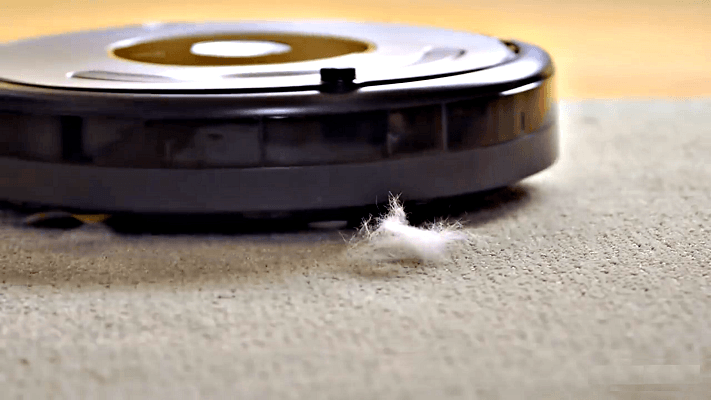
After the first few runs through the home, you can let the robot go a cycle or two without having to unclog the rollers. Once the robots begin keeping up with the chore load, your maintenance time will drop.
Frequently Asked Questions
Now I will take a few minutes to answer some of the more common questions about the Roomba vacuums and iRobot in particular. If you have further questions, you can use the comment section below.
Q. Can the Roomba learn more than one floor of your house?
A. The Roomba 614 and 675 don’t learn any floors of your house. They do not have mapping abilities or remember the layout. The Roomba 900 series was the first to introduce mapping functionality. The Roomba i7 and s9 models will learn, map and store multiple floors or layouts (up to 10).
Q. Do you have to have Wi-Fi to operate these robots?
A. No. Neither the Roomba 614 nor 675 require you to use wireless communications. The Roomba 614 doesn’t have WiFi abilities as it is, and the 675 will allow you to run the mobile app or voice commands on WiFi but with the local controls it isn’t needed to run the robot.
Q. Can I set the virtual walls up with the mobile app?
A. No. The virtual walls are physical towers that require you to turn the m on and place them where you need them. The digital containment options, which iRobot calls Imprint Technology, is found on the newer i- and s-series robots.
Q. How many square feet will these robots cover?
A. The coverage area will depend on the type of flooring being cleaned. With 90 minutes of runtime on hard flooring only, the 614 and 675 can cover about 900 to 1100 square feet. If you mix in carpeting, that will drop a couple of hundred square feet, on average.
Q. How do I contact Roomba customer service?
A. You can call iRobot at 1-800-727-9077. If you prefer email or live chat options, you can find the links and proper addresses for the requested department or region on the contact page.
What I Like About the Roomba 614
- Upgraded firmware gives you 90 minutes of runtime (hard flooring).
- Cleans most of the flooring types without complaint.
- Decent option for pet hair or smaller spaces.
What I Like About the Roomba 675
- Everything from the Roomba 614 list above, plus
- WiFi capabilities for mobile app and voice command usage.
- Can create and edit scheduled cleaning times.
Conclusion
When you break it all down the final choice comes to money or abilities. If you want to save the most amount of cash and don’t have the need or use for wireless controls, the Roomba 614 is a viable choice. It will clean most floor types (high pile carpet excluded), and does a decent job with pet hair.
However, for just a little more you can increase your productivity by going with the Roomba 675. The wireless communications and the mobile app usage alone are worth the extra few dollars. Add in the ability to create, edit and delete schedules at any time, from anywhere and it is a winner in my book.
